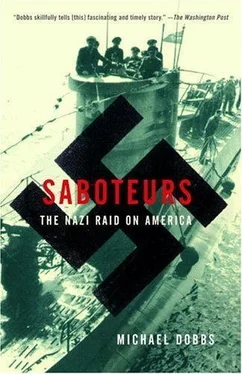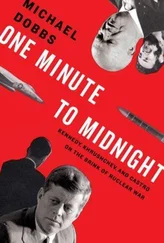Michael Dobbs
SABOTEURS
The Nazi Raid on America
ON THE APPROVED LIST of visitors to Adolf Hitler’s gloomy forest bunker for April 16, 1942, was a short, somewhat stocky German admiral with piercing blue eyes, bustling eyebrows, and a mane of carefully combed white hair. 1He was accompanied by a very tall, almost cadaverous Austrian colonel. Together, they looked a little like Don Quixote and Sancho Panza, except the shorter man was clearly in charge. The admiral exuded a coiled-up energy; his taller colleague had a refined, aristocratic air.
They had flown that morning from Berlin, a 350-mile journey across the plains of what had been northern Poland, now part of the Third Reich. Their plane landed on a grass airstrip near a little town called Rastenburg, in a remote area of East Prussia covered by a swath of primeval forest, interspersed with lakes and gentle hills. A staff car was waiting to meet them. Soon, they found themselves driving into the woods along a winding cobblestone road, over a railway line and past several small lakes that protected the approaches to the place known as Wolfsschanze, the Wolf’s Lair.
A succession of roadblocks, each more intimidating than the last, dotted the five-mile route to Hitler’s headquarters. Security arrangements were in the hands of the S.S., the Führer’s Praetorian guard. At each checkpoint, the black-shirted S.S. men ordered the officers to show their papers. There were telephone consultations with superiors further down the road. Once the guards were satisfied that everything was in order, they raised the barrier, giving the visitors a raised-arm, Heil Hitler salute.
After crossing a no-man’s-land of minefields and pillboxes, the visitors reached the innermost sanctum of Nazi power. Here, surrounded by an electrified barbed-wire fence, lay a fortified encampment of dozens of concrete bunkers and wooden huts hidden behind thick fir trees and elaborate camouflage nets. Within this enclosure was another, even more tightly guarded, compound bristling with antiaircraft guns and constantly patrolled by S.S. men. This area contained the bunker used by Hitler as his living quarters and a single-story wooden barracks where he held his midday conferences while supervising operations against the Soviet Union.
The compound was bathed in almost perpetual gloom: sunlight rarely penetrated this deep into the woods. Apart from the barking of the Führer’s Alsatian dog Blondi and the occasional shunting of trains along the nearby railway line, the sounds were those of the forest. Most of Hitler’s aides detested the Wolf’s Lair, finding it melancholy and oppressive. General Alfred Jodl, the army chief of staff, described the place as “a cross between a monastery and a concentration camp.” 2To Hitler’s architect, Albert Speer, the Führer’s bunker was like “an Egyptian tomb.” But Hitler felt comfortable here, far removed from the horrors of the eastern front and the political intrigues of Berlin. The dark forest provided an ideal backdrop for his furious tirades against the outside world. He would spend a total of eight hundred days in the Wolf’s Lair, more than in all his other wartime headquarters combined.
The shorter of the two visitors from Berlin was Admiral Wilhelm Canaris, chief of Hitler’s military intelligence and a man of almost legendary reputation. During the First World War, he had served on a U-boat. Since taking over leadership of the Abwehr in 1934, Canaris had transformed the intelligence operation from a bureaucratic backwater to an important arm of the Third Reich. His spies had helped lay the groundwork for Hitler’s stunning military successes of the last few years, including the unopposed takeover of Czechoslovakia, the blitzkrieg attack against Poland, and the invasion of the Soviet Union. The Abwehr was made up of three divisions: intelligence (Division I), sabotage (Division II), and counterintelligence (Division III).
Accompanying Canaris was the head of Abwehr II, Colonel Erwin von Lahousen-Vivremont. The scion of a noble Austrian family, Lahousen had been recruited to the Abwehr following his country’s annexation by the Third Reich in 1938. He had responsibility for overseeing covert operations—from issuing German soldiers with Polish uniforms in order to stage a “provocation” on the border between Poland and Germany, to smuggling members of the Irish Republican Army back into Ireland to fight the British.
As they walked down forest paths lined with metal trees sprouting green Bakelite leaves past windowless bunkers draped with seaweed, Canaris and Lahousen could not help but get a better understanding of the dark passions driving their Führer. Named Wolfsschanze in honor of its master—“Herr Wolf” had been one of Hitler’s political nicknames back in the twenties, when he was just an opposition leader—the Wolf’s Lair was a monument to his paranoia and megalomania. Built by an army of racially pure workers, the fortress in the forest was a Pharaonic project that provided secure accommodation not only for the Führer, but for two thousand of his closest aides and guards. It was here that Hitler put into effect Operation Barbarossa, his plan for the invasion and destruction of the Soviet Union.
But it was not Barbarossa that Hitler had in mind when he summoned his intelligence chiefs to the Wolf’s Lair on April 16, 1942. For some weeks now, his attention had been drifting away from the eastern front to the challenges posed by the emergence of a new enemy on the other side of the Atlantic, a country whose productive capabilities were so formidable that they threatened to overwhelm the military might of Nazi Germany. Hitler had a scheme that, if put into effect, would wreak havoc on America’s ability to make war.
The plan was known as Operation Pastorius.
LOOKING AT a map of the territory he controlled, Hitler had every reason to feel at the peak of his power in the spring of 1942. The failed artist and retired corporal had become the unchallenged master of much of the Old World, from the Caucasus Mountains to the English Channel, from the fjords of Norway to the deserts of North Africa. He saw himself as the “greatest German ever,” the more-than-worthy successor of Bismarck and Frederick the Great. He had more than avenged the humiliations heaped on Germany after World War I. Through a mixture of bullying, bluff, and blitzkrieg, his armies had sliced through supposedly impregnable defenses in Czechoslovakia, Poland, the Balkans, Belgium, Netherlands, France, and finally Russia. His plan for the annihilation of the Jewish race—a long-held dream—was well under way.
But the Führer was astute enough to understand that the propaganda accounts of an almost unbroken succession of military triumphs did not tell the whole story. Problems were surfacing that threatened the very foundations of the Third Reich and his own ability to hold on to absolute power. On the western edge of Europe, Great Britain remained a stubborn holdout, refusing to recognize the New Order Hitler had established for the rest of the continent. In the east, on the Russian front, the German juggernaut had ground to a halt in the depths of the Russian winter after a series of sweeping advances the previous summer. Ill prepared for blinding snowstorms and forty degrees of frost, tens of thousands of German soldiers had frozen to death on the windswept Russian plain, or had fallen in hand-to-hand fighting with a seemingly reinvigorated Red Army. Despite the easy capture of dozens of Soviet cities, including Kiev, Minsk, and Kharkov, Hitler’s soldiers had been unable to penetrate the defenses of Moscow and Leningrad, the two grand prizes.
Читать дальше













